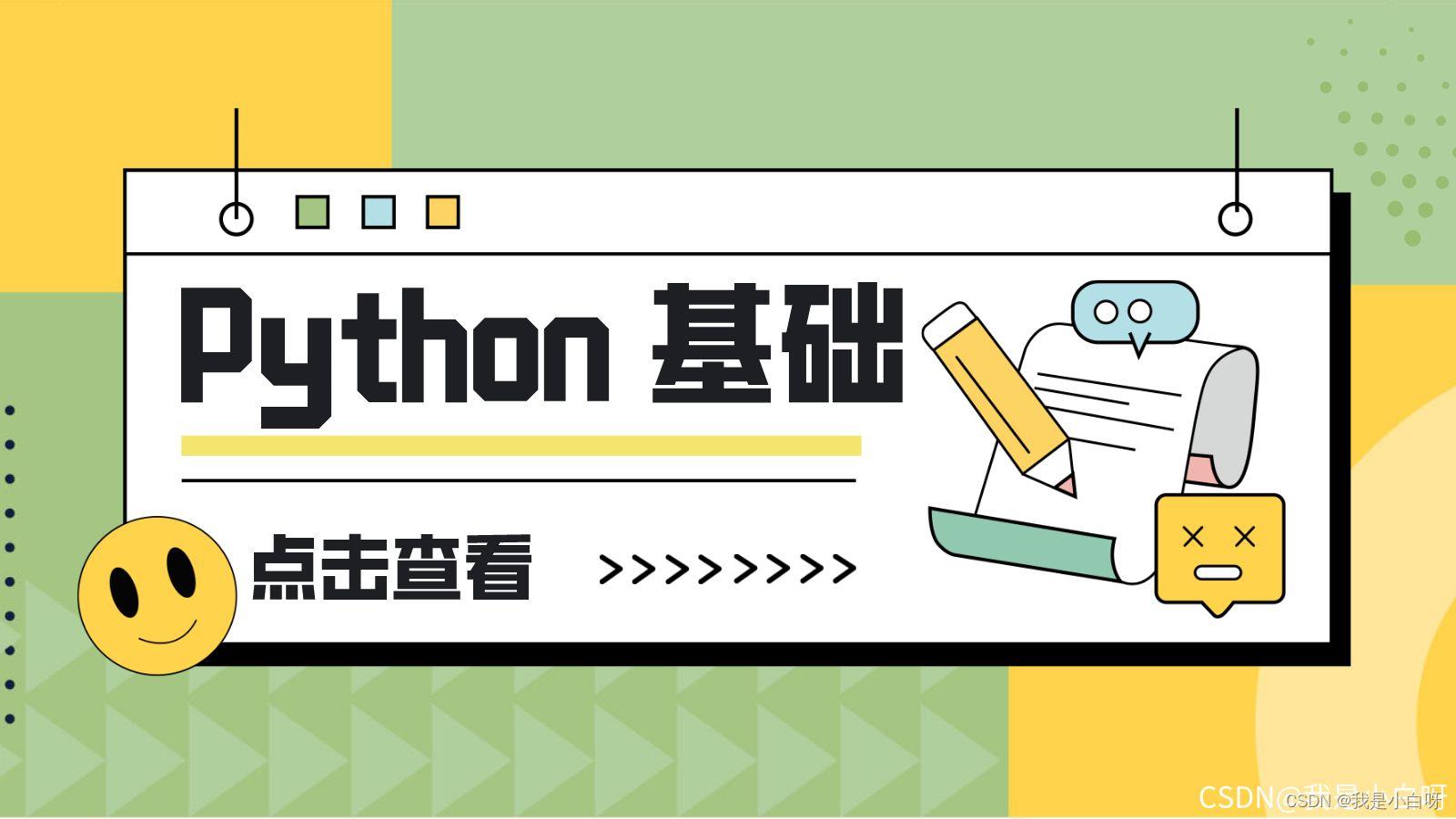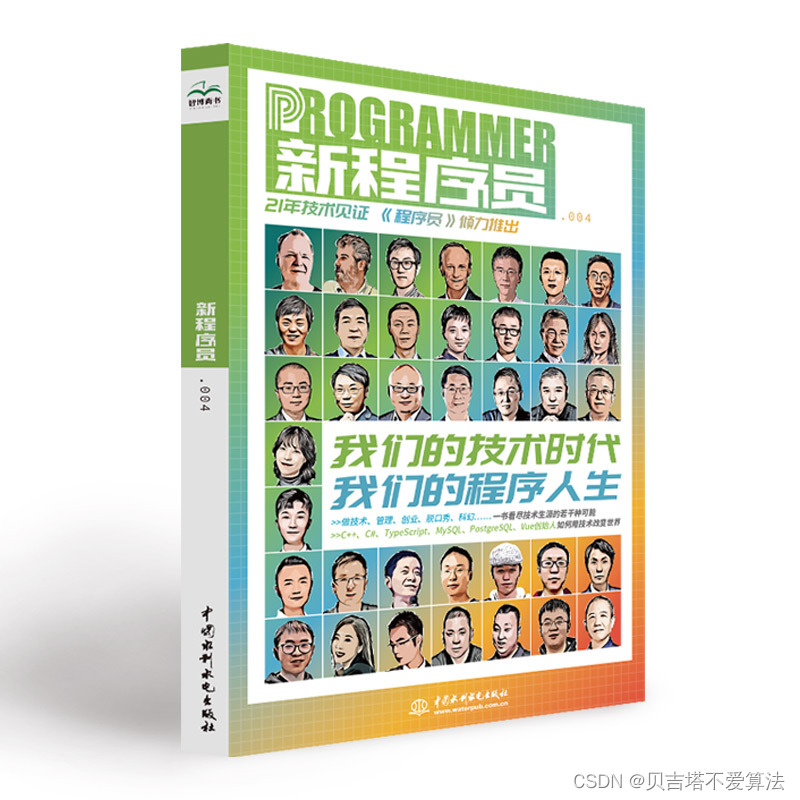Python 入门的60个基础练习
Posted taotaotao7777777
tags:
篇首语:本文由小常识网(cha138.com)小编为大家整理,主要介绍了Python 入门的60个基础练习相关的知识,希望对你有一定的参考价值。
文章目录
- 01-Hello World
- 02-print 函数
- 03-基本运算
- 04-input
- 05-输入输出基础练习
- 06-字符串使用基础
- 07-列表基础
- 08-元组基础
- 09-字典基础
- 10-基本判断
- 11-条件表达式、三元运算符
- 12-判断练习:用户名和密码是否正确
- 13-猜数:基础实现
- 14-成绩分类 1
- 15-成绩分类 2
- 16-石头剪刀布
- 17-改进的石头剪刀布
- 18-猜数,直到猜对
- 19-猜数,5 次机会
- 20-while 循环,累加至 100
- 21-while-break
- 22-while-continue
- 23-for 循环遍历数据对象
- 24-range 用法及数字累加
- 25-列表实现斐波那契数列
- 26-九九乘法表
- 27-逐步实现列表解析
- 28-三局两胜的石头剪刀布
- 29-文件对象基础操作
- 30-拷贝文件
- 31-拷贝文件
- 32-位置参数
- 33-函数应用-斐波那契数列
- 34-函数-拷贝文件
- 35-函数-九九乘法表
- 36-模块基础
- 37-生成密码/验证码
- 38-序列对象方法
- 39-序列对象方法 2
- 40-字符串方法
- 41-字符串格式化
- 42-shutil 模块常用方法
- 43-练习:生成文本文件
- 44-列表方法
- 45-检查合法标识符
- 46-创建用户,设置随机密码
- 47-列表练习:模拟栈操作
- 48-实现 Linux 系统中 unix2dos 功能
- 49-动画程序:@从一行#中穿过
- 50-字典基础用法
- 51-字典常用方法
- 52-集合常用方法
- 53-集合实例:取出第二个文件有,第一个文件没有的行
- 54-字典练习:模拟注册/登陆
- 55-计算千万次加法运算时间
- 56-时间相关模块常用方法
- 57-os 模块常用方法
- 58-pickle 存储器
- 59-异常处理基础
- 60-异常处理完整语法
01-Hello World
python 的语法逻辑完全靠缩进,建议缩进 4 个空格。 如果是顶级代码,那么必须顶格书写,哪怕只有一个空格也会有语法错误。 下面示例中,满足 if 条件要输出两行内容,这两行内容必须都缩进,而且具有相同的缩进级别。
print('hello world!')
if 3 > 0:
print('OK')
print('yes')
x = 3; y = 4 # 不推荐,还是应该写成两行
print(x + y)
02-print 函数
print('hello world!')
print('hello', 'world!') # 逗号自动添加默认的分隔符:空格 hello world!
print('hello' + 'world!') # 加号表示字符拼接 helloworld!
print('hello', 'world', sep='***') # 单词间用***分隔 hello***world
print('#' * 50) # *号表示重复 50 遍
print('how are you?', end='') # 默认 print 会打印回车,end=''表示不要回车
03-基本运算
- 运算符可以分为:算术运算符、比较运算符和逻辑运算符。优先级是:算术运算符>比较运算符>逻辑运算符。最好使用括号,增加了代码的可读性。
print(5 / 2) # 2.5
print(5 // 2) # 丢弃余数,只保留商
print(5 % 2) # 求余数
print(5 ** 3) # 5 的 3 次方
print(5 > 3) # 返回 True
print(3 > 5) # 返回 False
print(20 > 10 > 5) # python 支持连续比较
print(20 > 10 and 10 > 5) # 与上面相同含义
print(not 20 > 10) # False
04-input
number = input("请输入数字:") # input 用于获取键盘输入
print(number)
print(type(number)) # input 获得的数据是字符型
print(number + 10) # 报错,不能把字符和数字做运算
print(int(number) + 10) # int 可将字符串 10 转换成数字 10
print(number + str(10)) # str 将 10 转换为字符串后实现字符串拼接
05-输入输出基础练习
username = input('username: ')
print('welcome', username) # print 各项间默认以空格作为分隔符
print('welcome ' + username) # 注意引号内最后的空格
06-字符串使用基础
python 中,单双引号没有区别,表示一样的含义
sentence = 'tom\\'s pet is a cat' # 单引号中间还有单引号,可以转义
sentence2 = "tom's pet is a cat" # 也可以用双引号包含单引号
sentence3 = "tom said:\\"hello world!\\""
sentence4 = 'tom said:"hello world"'
# 三个连续的单引号或双引号,可以保存输入格式,允许输入多行字符串
words = """
hello
world
abcd"""
print(words)
py_str = 'python'
len(py_str) # 取长度
py_str[0] # 第一个字符
'python'[0]
py_str[-1] # 最后一个字符
# py_str[6] # 错误,下标超出范围
py_str[2:4] # 切片,起始下标包含,结束下标不包含
py_str[2:] # 从下标为 2 的字符取到结尾
py_str[:2] # 从开头取到下标是 2 之前的字符
py_str[:] # 取全部
py_str[::2] # 步长值为 2,默认是 1
py_str[1::2] # 取出 yhn
py_str[::-1] # 步长为负,表示自右向左取
py_str + ' is good' # 简单的拼接到一起
py_str * 3 # 把字符串重复 3 遍
't' in py_str # True
'th' in py_str # True
'to' in py_str # False
'to' not in py_str # True
07-列表基础
列表也是序列对象,但它是容器类型,列表中可以包含各种数据
alist = [10, 20, 30, 'bob', 'alice', [1,2,3]]
len(alist)
alist[-1] # 取出最后一项
alist[-1][-1] # 因为最后一项是列表,列表还可以继续取下标
[1,2,3][-1] # [1,2,3] 是列表,[-1] 表示列表最后一项
alist[-2][2] # 列表倒数第 2 项是字符串,再取出字符下标为 2 的字符
alist[3:5] # ['bob', 'alice']
10 in alist # True
'o' in alist # False
100 not in alist # True
alist[-1] = 100 # 修改最后一项的值
alist.append(200) # 向**列表中追加一项
08-元组基础
元组与列表基本上是一样的,只是元组不可变,列表可变。
atuple = (10, 20, 30, 'bob', 'alice', [1,2,3])
len(atuple)
10 in atuple
atuple[2]
atuple[3:5]
# atuple[-1] = 100 # 错误,元组是不可变的
09-字典基础
# 字典是 key-value(键-值)对形式的,没有顺序,通过键取出值
adict = 'name': 'bob', 'age': 23
len(adict)
'bob' in adict # False
'name' in adict # True
adict['email'] = 'bob@tedu.cn' # 字典中没有 key,则添加新项目
adict['age'] = 25 # 字典中已有 key,修改对应的 value
10-基本判断
单个的数据也可作为判断条件。 任何值为 0 的数字、空对象都是 False,任何非 0 数字、非空对象都是 True。
if 3 > 0:
print('yes')
print('ok')
if 10 in [10, 20, 30]:
print('ok')
if -0.0:
print('yes') # 任何值为 0 的数字都是 False
if [1, 2]:
print('yes') # 非空对象都是 True
if ' ':
print('yes') # 空格字符也是字符,条件为 True
11-条件表达式、三元运算符
a = 10
b = 20
if a < b:
smaller = a
else:
smaller = b
print(smaller)
s = a if a < b else b # 和上面的 if-else 语句等价
print(s)
12-判断练习:用户名和密码是否正确
import getpass # 导入模块
username = input('username: ')
# getpass 模块中,有一个方法也叫 getpass
password = getpass.getpass('password: ')
if username == 'bob' and password == '123456':
print('Login successful')
else:
print('Login incorrect')
13-猜数:基础实现
import random
num = random.randint(1, 10) # 随机生成 1-10 之间的数字
answer = int(input('guess a number: ')) # 将用户输入的字符转成整数
if answer > num:
print('猜大了')
elif answer < num:
print('猜小了')
else:
print('猜对了')
print('the number:', num)
14-成绩分类 1
score = int(input('分数:'))
if score >= 90:
print('优秀')
elif score >= 80:
print('好')
elif score >= 70:
print('良')
elif score >= 60:
print('及格')
else:
print('你要努力了')
15-成绩分类 2
score = int(input('分数:'))
if score >= 60 and score < 70:
print('及格')
elif 70 <= score < 80:
print('良')
elif 80 <= score < 90:
print('好')
elif score >= 90:
print('优秀')
else:
print('你要努力了')
16-石头剪刀布
import random
all_choices = ['石头', '剪刀', '布']
computer = random.choice(all_choices)
player = input('请出拳:')
# print('Your choice:', player, "Computer's choice:", computer)
print("Your choice: %s, Computer's choice: %s" % (player, computer))
if player == '石头':
if computer == '石头':
print('平局')
elif computer == '剪刀':
print('You WIN!!!')
else:
print('You LOSE!!!')
elif player == '剪刀':
if computer == '石头':
print('You LOSE!!!')
elif computer == '剪刀':
print('平局')
else:
print('You WIN!!!')
else:
if computer == '石头':
print('You WIN!!!')
elif computer == '剪刀':
print('You LOSE!!!')
else:
print('平局')
17-改进的石头剪刀布
import random
all_choices = ['石头', '剪刀', '布']
win_list = [['石头', '剪刀'], ['剪刀', '布'], ['布', '石头']]
prompt = """(0) 石头
(1) 剪刀
(2) 布
请选择 (0/1/2): """
computer = random.choice(all_choices)
ind = int(input(prompt))
player = all_choices[ind]
print("Your choice: %s, Computer's choice: %s" % (player, computer))
if player == computer:
print('\\033[32;1m 平局、033[0m')
elif [player, computer] in win_list:
print('\\033[31;1mYou WIN!!!\\033[0m')
else:
print('\\033[31;1mYou LOSE!!!\\033[0m')
18-猜数,直到猜对
import random
num = random.randint(1, 10)
running = True
while running:
answer = int(input('guess the number: '))
if answer > num:
print('猜大了')
elif answer < num:
print('猜小了')
else:
print('猜对了')
running = False
19-猜数,5 次机会
import random
num = random.randint(1, 10)
counter = 0
while counter < 5:
answer = int(input('guess the number: '))
if answer > num:
print('猜大了')
elif answer < num:
print('猜小了')
else:
print('猜对了')
break
counter += 1
else: # 循环被 break 就不执行了,没有被 break 才执行
print('the number is:', num)
20-while 循环,累加至 100
因为循环次数是已知的,实际使用时,建议用 for 循环
sum100 = 0
counter = 1
while counter < 101:
sum100 += counter
counter += 1
print(sum100)
21-while-break
break 是结束循环,break 之后、循环体内代码不再执行。
while True:
yn = input('Continue(y/n): ')
if yn in ['n', 'N']:
break
print('running...')
22-while-continue
计算 100 以内偶数之和。
continue 是跳过本次循环剩余部分,回到循环条件处。
sum100 = 0
counter = 0
while counter < 100:
counter += 1
# if counter % 2:
if counter % 2 == 1:
continue
sum100 += counter
print(sum100)
23-for 循环遍历数据对象
astr = 'hello'
alist = [10, 20, 30]
atuple = ('bob', 'tom', 'alice')
adict = 'name': 'john', 'age': 23
for ch in astr:
print(ch)
for i in alist:
print(i)
for name in atuple:
print(name)
for key in adict:
print('%s: %s' % (key, adict[key]))
24-range 用法及数字累加
# range(10) # [0, 1, 2, 3, 4, 5, 6, 7, 8, 9]
# >>> list(range(10))
# range(6, 11) # [6, 7, 8, 9, 10]
# range(1, 10, 2) # [1, 3, 5, 7, 9]
# range(10, 0, -1) # [10, 9, 8, 7, 6, 5, 4, 3, 2, 1]
sum100 = 0
for i in range(1, 101):
sum100 += i
print(sum100)
25-列表实现斐波那契数列
列表中先给定两个数字,后面的数字总是前两个数字之和。
fib = [0, 1]
for i in range(8):
fib.append(fib[-1] + fib[-2])
print(fib)
26-九九乘法表
for i in range(1, 10):
for j in range(1, i + 1):
print('%s*%s=%s' % (j, i, i * j), end=' ')
print()
# i=1 ->j: [1]
# i=2 ->j: [1,2]
# i=3 ->j: [1,2,3]
# 由用户指定相乘到多少
n = int(input('number: '))
for i in range(1, n + 1):
for j in range(1, i + 1):
print('%s*%s=%s' % (j, i, i * j), end=' ')
print()
27-逐步实现列表解析
# 10+5 的结果放到列表中
[10 + 5]
# 10+5 这个表达式计算 10 次
[10 + 5 for i in range(10)]
# 10+i 的 i 来自于循环
[10 + i for i in range(10)]
[10 + i for i in range(1, 11)]
# 通过 if 过滤,满足 if 条件的才参与 10+i 的运算
[10 + i for i in range(1, 11) if i % 2 == 1]
[10 + i for i in range(1, 11) if i % 2概述第五题 第六题 第七题 第八题 第五题 (答案) 第六题 (答案) 第七题 (答案) 第八题 (答案)
概述
从今天开始, 小白我将带领大家学习一下 Python 零基础入门的内容. 本专栏会以讲解 + 练习的模式, 带领大家熟悉 Python 的语法, 应用, 以及代码的基础逻辑.

第五题

def assignment():
# a. assign x the value 8
# b. assign both x and y the value 9 in one line of code
# c. assign x the value 10 and y the value 12 using one line of code
# d.
# run the program
assignment()
预期输出:
8
9 9
10 12
7
第六题

def even_odd(x):
# your code
# define some sample data
a=45
# run the program
even_odd(a)
预期输出:
odd
第七题

def check_max(lst):
# your code
# define some sample values
nums=[3, 41, 12, 9, 74, 15]
# run the program
check_max(nums)
预期结果:
74
第八题

# your code
check_balance(1000,1400)
check_balance(1000,800)
check_balance(1000,1200)
预期输出:
your account balance has increased by $ 400
your account balance has decreased by $ 200
No action is required at this time
第五题 (答案)
def assignment():
# a. assign x the value 8
x=8
print(x)
# b. assign both x and y the value 9 in one line of code
x=y=9
print(x,y)
# c. assign x the value 10 and y the value 12 using one line of code
x,y=10,12
print(x,y)
# d.
x=4
x+=1
x+=1
x+=1
print(x)
# run the program
assignment()
第六题 (答案)
def even_odd(x):
# your code
if x%2==0:
print('even')
else:
print('odd')
# define some sample data
a=45
# run the program
even_odd(a)
第七题 (答案)
def check_max(lst):
# your code
Max_num = None
for num in lst:
if (Max_num is None or num > Max_num):
Max_num = num
print(Max_num)
# define some sample values
nums=[3, 41, 12, 9, 74, 15]
# run the program
check_max(nums)
第八题 (答案)
# your code
def check_balance(num1, num2):
# 判断
if (num2 > num1 * 1.25):
print("your account balance has increased by $", num2 - num1)
elif (num2 < num1 * 0.98):
print("your account balance has decreased by $", num1 - num2)
else:
print("No action is required at this time")
# 调用
check_balance(1000,1400)
check_balance(1000,800)
check_balance(1000,1200)
输出结果:
your account balance has increased by $ 400
your account balance has decreased by $ 200
No action is required at this time
 开发者涨薪指南
开发者涨薪指南
 48位大咖的思考法则、工作方式、逻辑体系
48位大咖的思考法则、工作方式、逻辑体系
以上是关于Python 入门的60个基础练习的主要内容,如果未能解决你的问题,请参考以下文章